作者:李岩科
1 背景
SpringBoot 是一个框架,一种全新的编程规范,他的产生简化了框架的使用,同时也提供了很多便捷的功能,比如内置 tomcat 就是其中一项,他让我们省去了搭建 tomcat 容器,生成 war,部署,启动 tomcat。因为内置了启动容器,应用程序可以直接通过 Maven 命令将项目编译成可执行的 jar 包,通过 java -jar 命令直接启动,不需要再像以前一样,打包成 War 包,然后部署在 Tomcat 中。那么内置 tomcat 是如何实现的呢
2 tomcat 启动过程及原理
2.1 下载一个 springboot 项目
在这里下载一个项目 https://start.spring.io/ 也可以在 idea 新建 SpringBoot-Web 工程.
<dependency> <groupId>org.springframework.boot</groupId> <artifactId>spring-boot-starter-web</artifactId></dependency>
复制代码
点击 pom.xml 会有 tomcat 依赖
<dependency><groupId>org.springframework.boot</groupId><artifactId>spring-boot-starter-tomcat</artifactId><version>2.1.2.RELEASE</version><scope>compile</scope></dependency>
复制代码
2.2 从启动入口开始一步步探索
点击进入 run 方法
public static ConfigurableApplicationContext run(Class<?> primarySource,String... args) {return run(new Class<?>[] { primarySource }, args);}
//继续点击进入run方法public static ConfigurableApplicationContext run(Class<?>[] primarySources,String[] args) {return new SpringApplication(primarySources).run(args);}
复制代码
进入到这个 run 方法之后就可以看到,我们认识的一些初始化事件。主要的过程也是在这里完成的。
2.3 源码代码流程大致是这样
/*** Run the Spring application, creating and refreshing a new* {@link ApplicationContext}.* @param args the application arguments (usually passed from a Java main method)* @return a running {@link ApplicationContext}*/public ConfigurableApplicationContext run(String... args) {StopWatch stopWatch = new StopWatch();stopWatch.start();ConfigurableApplicationContext context = null;Collection<SpringBootExceptionReporter> exceptionReporters = new ArrayList<>();/**1、配置系统属性*/configureHeadlessProperty();/**2.获取监听器*/SpringApplicationRunListeners listeners = getRunListeners(args);/**发布应用开始启动事件 */listeners.starting();try {/** 3.初始化参数 */ApplicationArguments applicationArguments = new DefaultApplicationArguments(args);/** 4.配置环境*/ConfigurableEnvironment environment = prepareEnvironment(listeners,applicationArguments);
configureIgnoreBeanInfo(environment);Banner printedBanner = printBanner(environment);/**5.创建应用上下文*/context = createApplicationContext();exceptionReporters = getSpringFactoriesInstances(SpringBootExceptionReporter.class,new Class[] { ConfigurableApplicationContext.class }, context);/**6.预处理上下文*/prepareContext(context, environment, listeners, applicationArguments,printedBanner);
/**6.刷新上下文*/refreshContext(context);afterRefresh(context, applicationArguments);stopWatch.stop();if (this.logStartupInfo) {new StartupInfoLogger(this.mainApplicationClass).logStarted(getApplicationLog(), stopWatch);}/** 8.发布应用已经启动事件 */listeners.started(context);callRunners(context, applicationArguments);}catch (Throwable ex) {handleRunFailure(context, ex, exceptionReporters, listeners);throw new IllegalStateException(ex);}
try {/** 9.发布应用已经启动完成的监听事件 */listeners.running(context);}catch (Throwable ex) {handleRunFailure(context, ex, exceptionReporters, null);throw new IllegalStateException(ex);}return context;}
复制代码
代码中主要就是通过 switch 语句,根据 webApplicationType 的类型来创建不同的 ApplicationContext:
DEFAULT_SERVLET_WEB_CONTEXT_CLASS:Web 类型,实例化 AnnotationConfigServletWebServerApplicationContext
DEFAULT_REACTIVE_WEB_CONTEXT_CLASS:响应式 Web 类型,实例化 AnnotationConfigReactiveWebServerApplicationContext
DEFAULT_CONTEXT_CLASS:非 Web 类型,实例化 AnnotationConfigApplicationContext
2.4 创建完应用上下文之后,我们在看刷新上下文方法
一步步通过断点点击方法进去查看,我们看到很熟悉代码 spring 的相关代码。
@Overridepublic void refresh() throws BeansException, IllegalStateException {synchronized (this.startupShutdownMonitor) {// Prepare this context for refreshing.//初始化前的准备工作,主要是一些系统属性、环境变量的校验,比如Spring启动需要某些环境变量,可以在这个地方进行设置和校验prepareRefresh();
// Tell the subclass to refresh the internal bean factory.ConfigurableListableBeanFactory beanFactory = obtainFreshBeanFactory();
// Prepare the bean factory for use in this context.//准备bean工厂 注册了部分类prepareBeanFactory(beanFactory);
try {// Allows post-processing of the bean factory in context subclasses.postProcessBeanFactory(beanFactory);
// Invoke factory processors registered as beans in the context.//注册bean工厂后置处理器,并解析java代码配置bean定义invokeBeanFactoryPostProcessors(beanFactory);
// Register bean processors that intercept bean creation.//注册bean后置处理器,并不会执行后置处理器,在后面实例化的时候执行registerBeanPostProcessors(beanFactory);
// Initialize message source for this context.initMessageSource();
// Initialize event multicaster for this context.//初始化事件监听多路广播器initApplicationEventMulticaster();
// Initialize other special beans in specific context subclasses.//待子类实现,springBoot在这里实现创建内置的tomact容器onRefresh();
// Check for listener beans and register them.registerListeners();
// Instantiate all remaining (non-lazy-init) singletons.finishBeanFactoryInitialization(beanFactory);
// Last step: publish corresponding event.finishRefresh();}
catch (BeansException ex) {if (logger.isWarnEnabled()) {logger.warn("Exception encountered during context initialization - " +"cancelling refresh attempt: " + ex);}
// Destroy already created singletons to avoid dangling resources.destroyBeans();
// Reset 'active' flag.cancelRefresh(ex);
// Propagate exception to caller.throw ex;}
finally {// Reset common introspection caches in Spring's core, since we// might not ever need metadata for singleton beans anymore...resetCommonCaches();}}}
复制代码
2.5 onRefresh () 方法是调用其子类实现的
也就是 ServletWebServerApplicationContext
/** 得到Servlet工厂 **/this.webServer = factory.getWebServer(getSelfInitializer());
复制代码
其中 createWebServer () 方法是用来启动 web 服务的,但是还没有真正启动 Tomcat,只是通过 ServletWebServerFactory 创建了一个 WebServer,继续来看这个 ServletWebServerFactory:
this.webServer = factory.getWebServer (getSelfInitializer ()); 这个方法可以看出 TomcatServletWebServerFactory 的实现。相关 Tomcat 的实现。
2.6 TomcatServletWebServerFactory 的 getWebServer () 方法
清晰的看到 new 出来了一个 Tomcat.
2.7 Tomcat 创建之后,继续分析 Tomcat 的相关设置和参数
@Overridepublic WebServer getWebServer(ServletContextInitializer... initializers) {
/** 1、创建Tomcat实例 **/Tomcat tomcat = new Tomcat();//创建Tomcat工作目录File baseDir = (this.baseDirectory != null) ? this.baseDirectory: createTempDir("tomcat");tomcat.setBaseDir(baseDir.getAbsolutePath());Connector connector = new Connector(this.protocol);tomcat.getService().addConnector(connector);customizeConnector(connector);/** 2、给创建好的tomcat设置连接器connector **/tomcat.setConnector(connector);/** 3.设置不自动部署 **/tomcat.getHost().setAutoDeploy(false);/** 4.配置Tomcat容器引擎 **/configureEngine(tomcat.getEngine());for (Connector additionalConnector : this.additionalTomcatConnectors) {tomcat.getService().addConnector(additionalConnector);}/**准备Tomcat的StandardContext,并添加到Tomcat中*/prepareContext(tomcat.getHost(), initializers);/** 将创建好的Tomcat包装成WebServer返回**/return getTomcatWebServer(tomcat);}
复制代码
2.8 继续点击 getTomcatWebServer 方法,找到 initialize () 方法,可以看到 tomcat.start (); 启动 tomcat 服务方法。
// Start the server to trigger initialization listeners//启动tomcat服务this.tomcat.start();//开启阻塞非守护进程startDaemonAwaitThread();
复制代码
//Tomcat.java
2.9 TomcatWebServer.java 控制台会打印这句话
Tomcat started on port(s): 8080 (http) with context path ‘’
3 总结
SpringBoot 的启动主要是通过实例化 SpringApplication 来启动的,启动过程主要做了如下几件事情:
配置系统属性、获取监听器,发布应用开始启动事件、初始化参数、配置环境、创建应用上下文、预处理上下文、刷新上下文、再次刷新上下文、发布应用已经启动事件、发布应用启动完成事件。而启动 Tomcat 是刷新上下文 这一步。
Spring Boot 创建 Tomcat 时,会先创建一个上下文,将 WebApplicationContext 传给 Tomcat;
启动 Web 容器,需要调用 getWebserver (),因为默认的 Web 环境就是 TomcatServletWebServerFactory,所以会创建 Tomcat 的 Webserver,这里会把根上下文作为参数给 TomcatServletWebServerFactory 的 getWebServer ();启动 Tomcat,调用 Tomcat 中 Host、Engine 的启动方法。
3.1 Tomcat 相关名称介绍


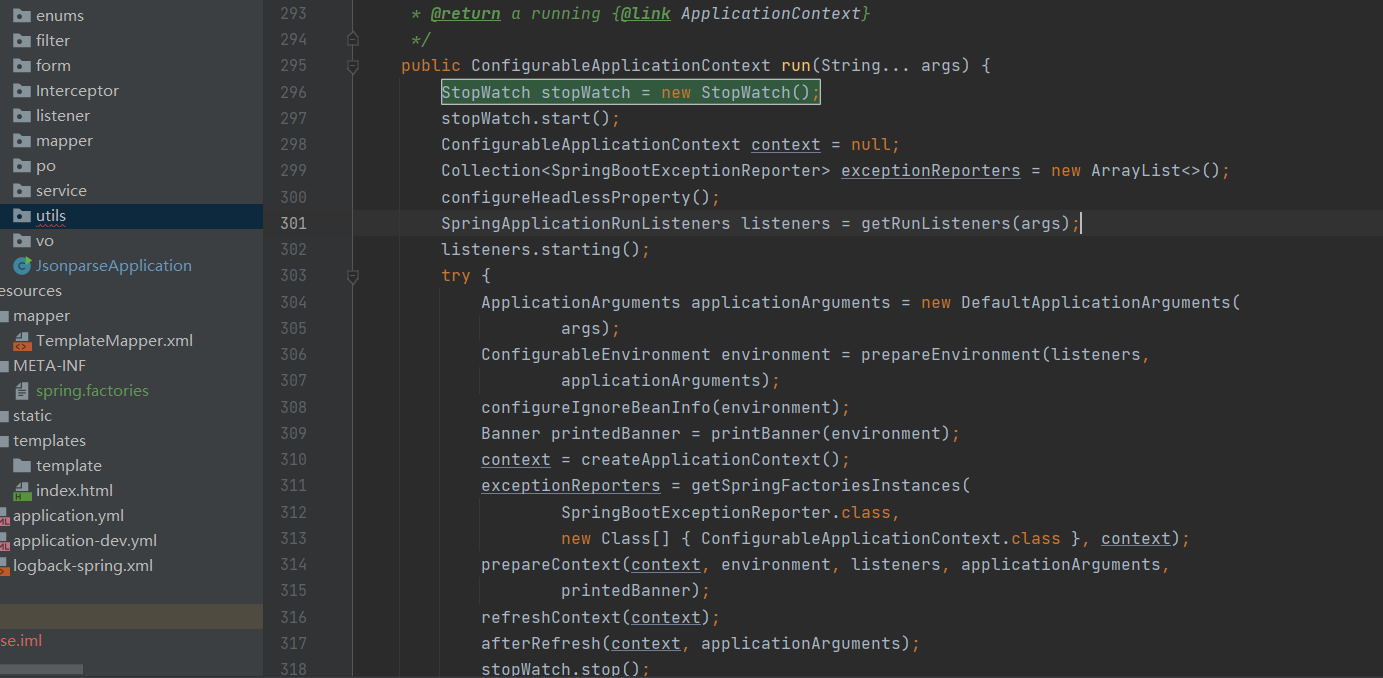




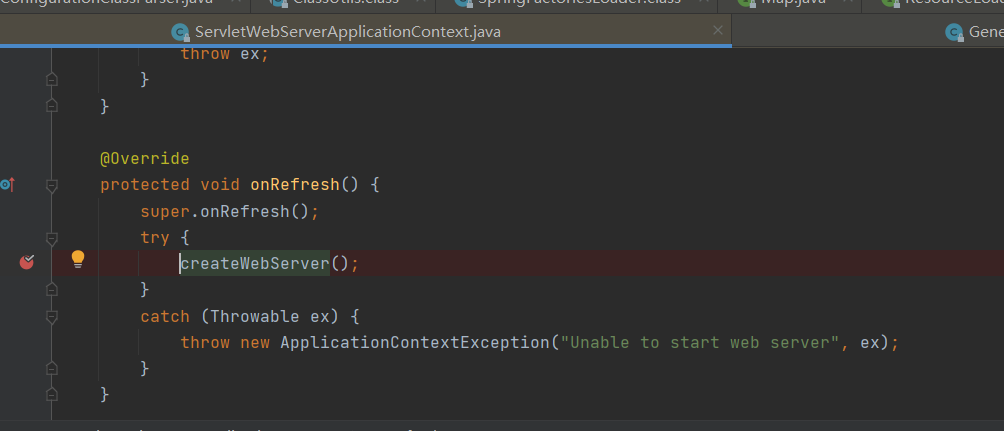
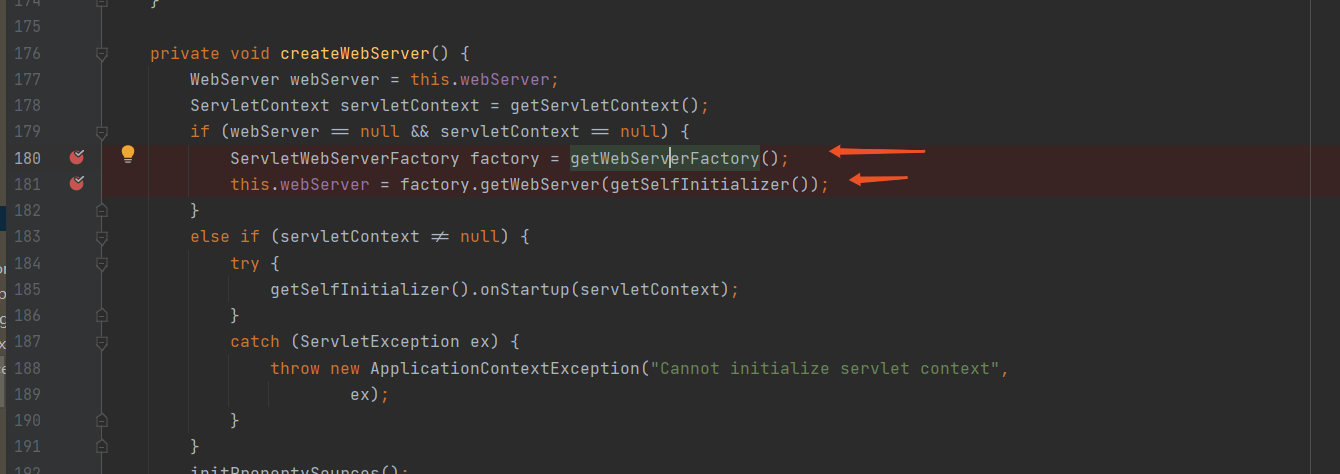


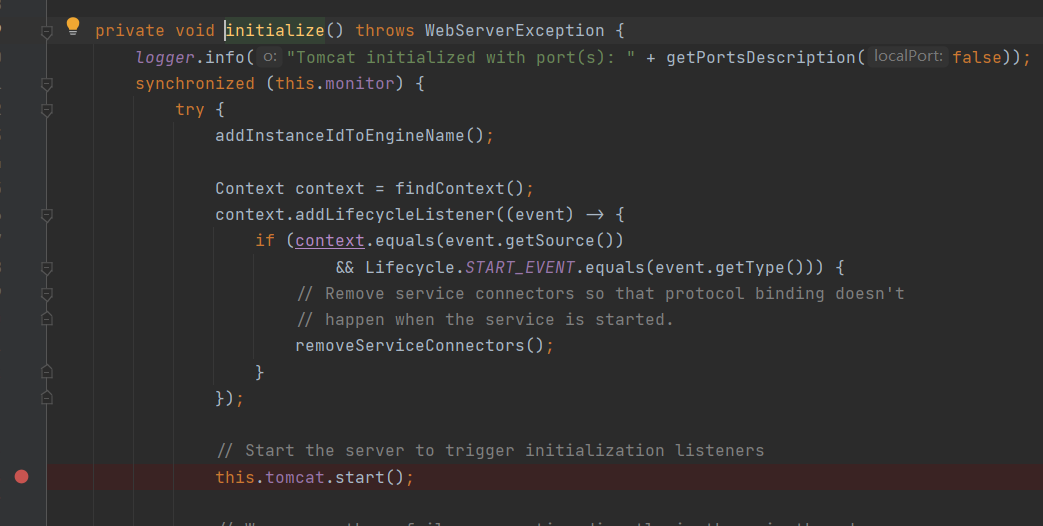

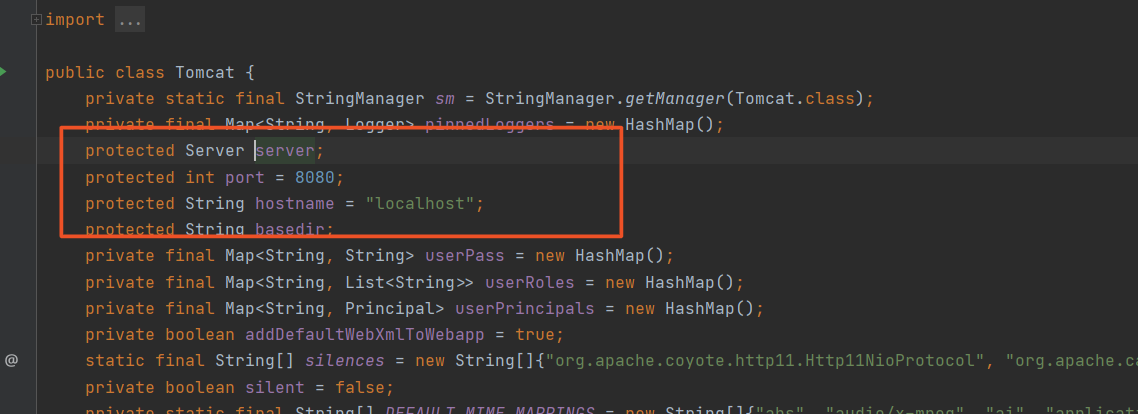
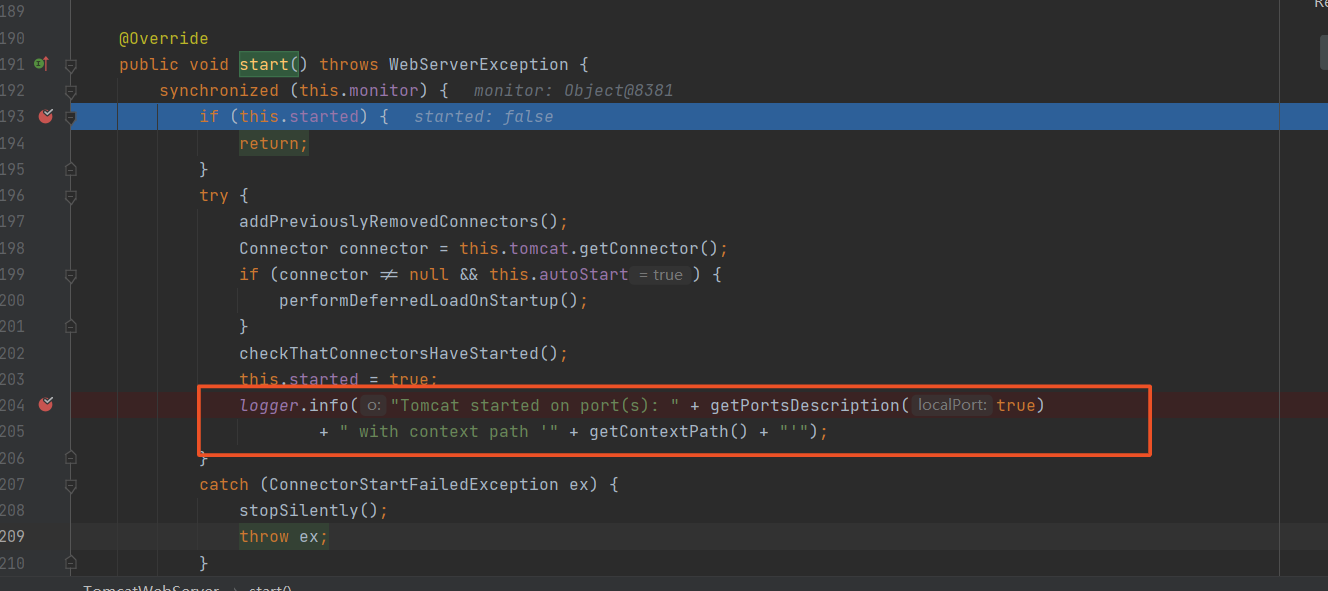











评论